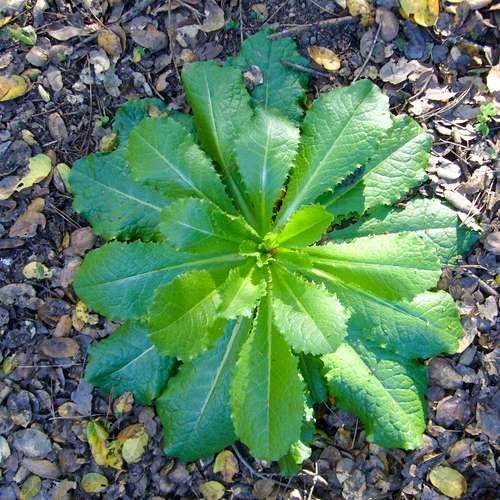Scientic name: Lactuca virosa L.
Family: Asteraceae/Compositae
Other names: Bitter Lettuce, Great Lettuce, Lettuce Opium, Prickly Lettuce, Strong-Scented Lettuce, Green Endive, Lettuce Opium, Acrid Lettuce, Poison Lettuce, Wild Lettuce
Not to be Confused With: Lactuca sativa, Lactuca serriola, Lactuca quercina and Sonchus oleraceus.
Habitat: The plant is indigenous to western and southern Europe and is cultivated in Germany, Austria, France and Scotland.
Constituents
All parts of the plant contain a milky, white latex (sap) which, when collected and dried, forms the drug known as lactucarium. (Barnes et al)
Acids: Citric, malic and oxalic (up to 1%) acids; cichoric acid (phenolic).
Alkaloids: Hyoscyamine, later disputed. N-methyl-b-phenethylamine, also disputed.
Coumarins: Aesculin, cichoriin.
Flavonoids: Flavones (e.g. apigenin, luteolin), flavonols (e.g. quercetin) and their glycosides.
Terpenoids: Bitter principles including the sesquiterpene lactones lactucin and lactupicrin (lactucopicrin); b-amyrin, germanicol, and lactucone (lactucerin). Lactucone is a mixture of a- and b-lactucerol acetates, b-lactucerol being identical to taraxasterol.
Other constituents: Mannitol, proteins, resins and sugars.
Medicinal Parts
The medicinal parts are the dried latex and the leaves.
Production
Lactucarium leaves are the leaves of the aerial part of Lactuca virosa. They are gathered when in flower and then dried.
Indications and Uses
The herb is supposed to have a narcotic effect. It is an analgesic and spasmolytic, and is said to act as a tranquilizer.
Traditionally used to treat whooping cough attacks. The herb is used for bronchial catarrh, asthma and urinary tract diseases. The oil of the seeds is used for arteriosclerosis and was also used as wheat germ oil.
Homeopathic Uses: Lactuca virosa is used for laryngitis, tracheitis with heavy coughing, for swelling of the liver and for urinary complaints.
Overdose
The following signs of poisoning can occur through overdosage or following intake of the fresh leaves, as in salads: outbreaks of sweating, acceleration of breathing, tachycardia, pupil dilation, dizziness, ringing in the ears, vision disorders, pressure in the head, somnolence, on occasion also excitatory states. The toxicity is, however, relatively low. Following gastrointestinal emptying (inducement of vomiting), as well as instillation of activated charcoal, the treatment of poisonings should proceed symptomatically.
Precautions and Adverse Reactions
No health hazards or side effects are known in conjunction with the proper administration of designated therapeutic dosages. The herb possesses a low potential for sensitization.

Dose
Dosages for oral administration (adults) for traditional uses recommended in older and contemporary standard herbal and pharmaceutical reference texts are given below: (Barnes etal)
Dried leaves: 0.5–3.0 g as an infusion, 3 times daily.
Liquid extract: 0.5–3.0 mL (1 : 1 in 25% alcohol), 3 times daily.
Lactucarium (dried latex extract) (BPC 1934): 0.3–1.0 g, 3 times daily.
Soft extract (BPC 1934): 0.3–1.0 g, 3 times daily.
Herbal Formulas
Pain and headache: a tincture of willow bark, wild lettuce juice, feverfew leaf, meadowsweet leaf and flower, St. John’s wort flower, and lavender leaf and flower.
Gastric ulcers: Besides bacterial infection, the cause of gastric ulcers can be nerve-related, so nerve soothers and feeders will be useful. Try equal amounts of chamomile flower, wood betony leaf, skullcap leaf, and wild lettuce leaves.
Nymphomania: Formula. Equal parts: Black Willow, Agnus Castus, Wild Lettuce. Dose: Liquid extracts: 2 teaspoons. Tinctures: 2-3 teaspoons. Powders: 750mg (three 00 capsules or half a teaspoon). Thrice daily. (Bartram)
Facial Neuralgia: Equal parts: Jamaica Dogwood, Wild Lettuce, Valerian. Dose: Liquid extracts: 1 teaspoon. Tinctures: 2 teaspoons. Powders: 500mg (two 00 capsules or one-third teaspoon). Thrice daily. (Bartram)
Hyperacidity: Powders, liquid extracts, tinctures. Formula: Valerian 1; Hops (Lupulin) 1; Wild Lettuce 2. Dose: Powders, 500mg (two 00 capsules or one-third teaspoon). Liquid Extracts, 30-60 drops. Tinctures, 1-2 teaspoons, thrice daily. (Bartram)
Headache, Stress, Neuralgia: The combination of wild lettuce and valerian root, used as a tincture, or capsules (HerbalLegacy .com)
Reference(s)
The Complete Home Guide to Herbs, Natural Healing, and Nutrition by Jill Rosemary Davies
Bartram’s Encyclopedia of Herbal Medicine by Thomas Bartram
Herbal Medicines Third Edition by Joanne Barnes, Linda A Anderson, J David Phillipson
HerbalLegacy.com
This article is copyrighted by Ital is Vital, 2025. Want to re-post this article? Visit our guidelines.
DISCLAIMER: THIS WEBSITE DOES NOT PROVIDE MEDICAL ADVICE
The information, including but not limited to, text, graphics, images and other material contained on this website are for informational purposes only. The purpose of this website is to promote broad consumer understanding and knowledge of various health topics. It is not intended to be a substitute for professional medical advice, diagnosis or treatment. Always seek the advice of your physician or other qualified health care provider with any questions you may have regarding a medical condition or treatment and before undertaking a new health care regimen, and never disregard professional medical advice or delay in seeking it because of something you have read on this website.
